Saturday, September 29, 2012
This year it so happened that the Mid-Autumn Festival occurred the day before the National Holiday. That meant one extended holiday instead of two separate holidays.
The usual procedure is for expats to leave the country during Chinese holidays, when the Chinese fill every local tourist venue to overflowing. So we decided to go to Seoul, South Korea.
We flew from Shanghai's Hongqiao Airport:
Every airport and train station has hot water available. Many people bring (or you can purchase) instant ramen-type noodles: Just add hot water and you have a meal.
Our flight was delayed an hour. We arrived at the hotel, checked-in, and set out by Metro for the Banpo-daegyo/Banpo Bridge.
We had hoped to see a fountain light show, but nothing happened...
Which was a bit surprising, because these three days, September 29-October 1, made up the Korean holiday of
Chuseok, like a Korean Thanksgiving.
Sunday, September 30, 2012
We had breakfast at the hotel restaurant, then took the Metro to the War Memorial of Korea.
The first thing you see is the memorial called "The Brothers:"
Showing a S Korean officer and a N Korean soldier who met on the battlefield, standing on a dome with a split representing the division of the country.
Inside the dome are mosaic murals:
In the center of Peace Plaza is the Korean War Monument:
The central "tower" represents a bronze sword and the tree of life.

KSS
The statue group called "Defending the Fatherland" depicts people, both soldiers and refugees:

KSS
The Outdoor Exhibition Area has over 100 pieces of equipment:

KSS
Including a PKM 301 Chamsuri class patrol boat, marked to replicate the battle-damaged PKM 357 following the Second Battle of Yeonpyeong:

KSS
A Curtiss C-46 plane (like Grandpa S's plane):

KSS
N Korean guerrilla fighters used this semi-submarine to infiltrate South Korea at Busan in 1983:

KSS
Inside the museum of the world's largest war memorial, is Memorial Hall with three sections ending up in a domed room with sunlight shining into a pool of water, symbolizing creation:
The War History Rooms on the first floor tell the story of the people's resistance to foreign aggression since prehistoric times.
There is a replica of the
geobukseon, the turtle-shaped warship, credited to Admiral Yi Sun-sin, which helped the Royal Korean Navy defeat the Japanese in 1598:
The Korean War Exhibition Rooms on the 2nd and 3rd floors give details of the conflict and the nations that participated are very much represented. Sixteen nations sent troops to fight as the United Nations Command Alliance. Joining the Republic of Korea and the United States, were Great Britain, Australia, Belgium, Canada, Colombia, Ethiopia, France, Greece, Luxembourg, the Netherlands, New Zealand, the Philippines, South Africa, Thailand, and Turkey. Denmark, India, Italy, Norway and Sweden sent medical personnel.
The Expeditionary Forces Room showed the Republic of Korea (ROK) forces participating in the Vietnam War and UN peacekeeping efforts.
The ROK Armed Forces Room
documents the Korean
Army, Navy, Air Force and Marine Corps from the time of their inception until today.
The Large & Defense Industries Equipment Room had the Aircraft Parachutes Exhibition in the Air:
Featuring a ROKAF L-5 liaison aircraft along with a helicopter and a couple parachuters.(And a children's play area below!)
A bulletin board for comments:
Posted in neat rows!
We skipped the Combat Experience Room, and the Cinema...
For a comprehensive gallery of photos of the War Memorial of Korea, click here
A.
After a couple more Metro trains, we came to the first of four palaces we were to visit. We expected to purchase an All-Palace ticket, but admission was free today!
Changdeokgung, part of
Donggwol/East Palace, was the secondary palace built in 1405. After being destroyed by the Japanese in 1592-1598, it was rebuilt in 1610 and served as the main palace until 1868. It was declared a UNESCO World Heritage Site in 1997.
Donhwamun, the main gate, was built in 1412, burned in 1592 and restored in 1608:
Palaces were built near auspicious streams. The
Geumcheongyo/"Bridge over the beautiful, silky stream:"
was built in 1411 and is the oldest bridge in Seoul.
Injeongjeon/the Throne Hall:
Guardian animals on the eave:

KSS
Detail of eave decoration:

KSS
The throne hall:
It was westernized in 1908 with chandeliers and draperies.
The blue-tiled roof of
Seonjeongjeon:
Seonjeongjeon was where the king met with high-ranking officials each day:

KSS
Next door is the
Huijeongdang/the King's office:

KSS
Behind the office is
Daejojeon/the Queen's residence. Its courtyard is surrounded by corridors:
Ornately painted corridor ceiling:

KSS
Many children were dressed in traditional costume for the Thanksgiving holiday:

KSS
A few adults as well:
Tamiko in her every-day clothing:

KSS
Changdeokgung is remarkable for fitting into the hillsides and harmonizing with the environment:

KSS
Outer walls and a water drain:

KSS
The
Samsamwa Pavilion of the
Seonjeonggak area:
This was the domain of the crown prince. Since the prince is the rising son/sun, so to speak, his palace was always to the east.
Nakseonjae was built by King Heonjong in 1847:
He did not use colorful paint decorations. This palace was used until 1989 by the widow of the last crown prince.
Being a holiday, there were large crowds, and entrance to the
Biwon/Secret Garden behind
Changdeokgung was limited to guided tours. We were willing to join a tour in any language, but they were booked far into the afternoon.
So we slipped through the back gate into the
Changgyeonggung section of
Donggwol/the East Palace. This palace was built for three dowager queens when it became too crowded at Changdeokgung, but on the grounds of a former palace.
A child in traditional dress enjoys an ice cream:
We started in the backyard of
Changgyeonggung, at the
Punggidae:
The
Punggidae is a measuring instrument made up of a piece of cloth tied to the end of a long pole. Why, it measures the intensity and speed of the wind!
Other measuring devices were also on display; an
Angbuilgu, a concave sundial:

KSS
Um, another more ancient sundial?
Taesil of King Seongjong:
A
taesil is used to store the placenta and umbilical cord of the royal family.
Holiday lanterns around
Chundangji/lake:
The Octagonal Seven-Storied Stone Pagoda:
Made in China in 1470.
Chundangji - the lower part of the lake was once rice paddies that the king would tend; this is the scenic upper portion:
The "Glass House" was the botanical garden:
We circled around to the main gate of
Honghwamun:
Built in 1484, burned in 1592, rebuilt in 1616, this gate is unique in that it faces east rather than south.
The
Okcheongyo/Bridge:
Myeongjeongmun/Gate doors:
Myeongjeongjeon/Throne Hall:

KSS
Detail of door carving:

KSS
Girls in traditional dress:
Kent attempts to get a coin to land on top of the carved stone:
He succeeds!
We don't know what kind of luck he will get, since we only had Chinese coins to toss!
Seoul is a great city, except at this time of year, you occasionally got a whiff of something that smelled like vomit. The culprit: gingko fruit!
It's lunch time!



































































































